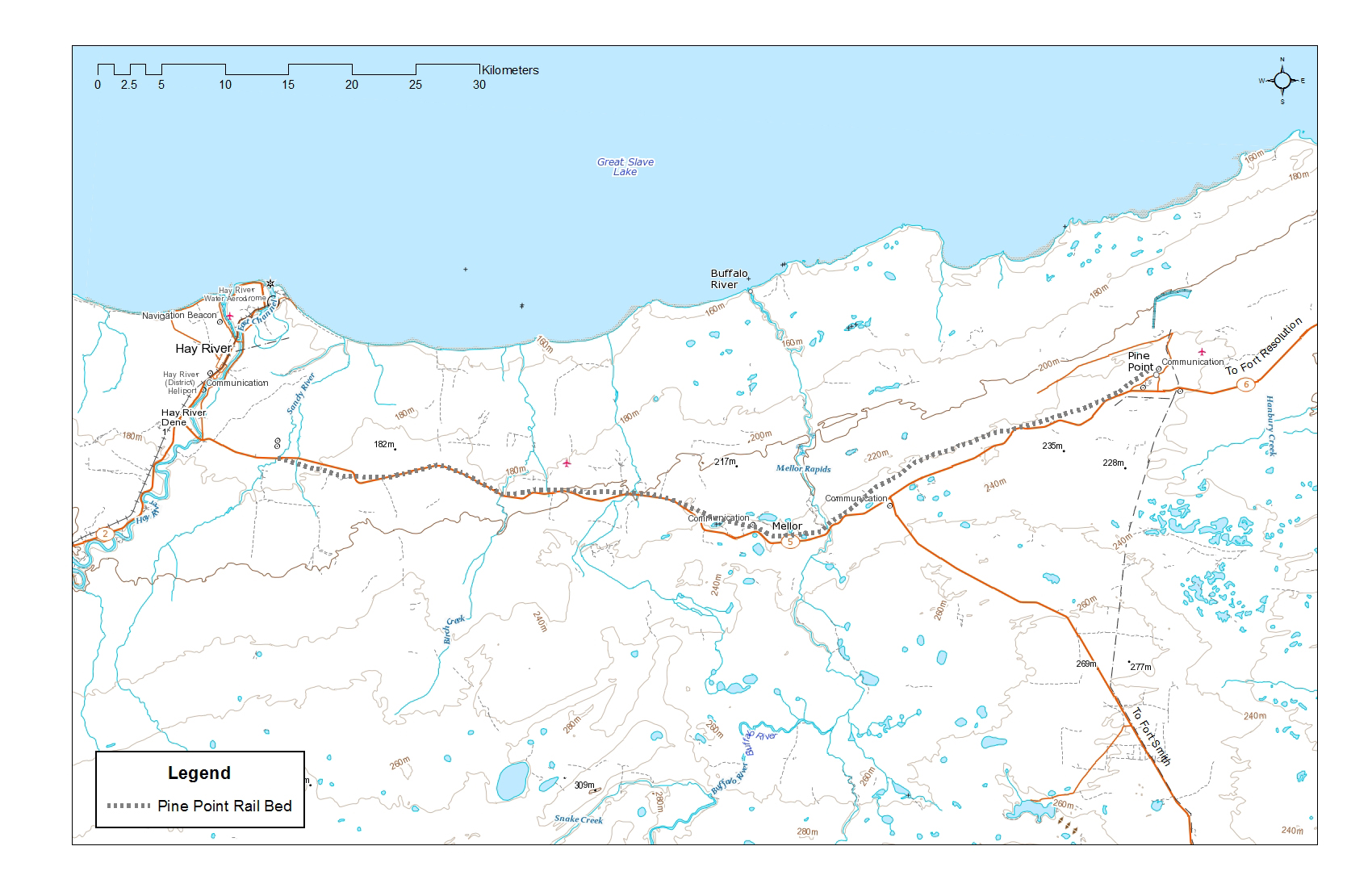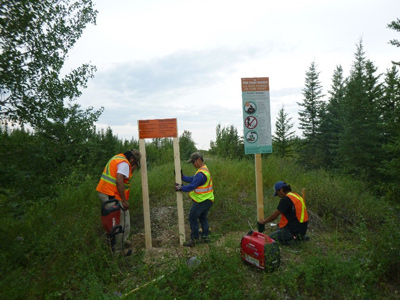Pine Point Railbed Remediation Project
Learn about the Pine Point Railbed Remediation Project, the work that’s been done to date and what’s ahead.
Public health notice
Studies found elevated levels of metals along the former Pine Point railbed. The governments of Canada and the Northwest Territories remind residents of health risks related to some activities on the former Pine Point railbed.
Cadmium and lead found in the surface soils and on vegetation along the former railbed pose a low health risk if ingested. To avoid spreading these metals, please don’t take quarry material from the former railbed.
To lower risks to your health:

wear a mask when riding an ATV

do not let children play in the contaminated dirt

thoroughly wash berries, mushrooms and edible plants before eating them
Learn more about issues at the site.
On this page
Overview
The Pine Point railbed is about 80 km long. It runs parallel to the south shore of Great Slave Lake in the Northwest Territories. The railbed runs from east of Hay River to the decommissioned Pine Point Mine, near Fort Resolution.

Visual description of the map showing the path of the railbed at the former Pine Point Mine in the Northwest Territories:
The railbed at the former Pine Point Mine, NWT is about 80 km long. Its westernmost point begins east of Hay River. The railbed path runs along the south shore of Great Slave Lake to the decommissioned Pine Point Mine, west of Fort Resolution.
Canadian National Railway operated the railway from 1964 to 1988. During this time, it was used to transport lead and zinc concentrate from the Cominco Mine near Pine Point. The railbed was abandoned in 1988 after ore concentrate shipments stopped following the closure of the mine. Over 60 million tonnes of ore as well as lead and zinc concentrate were hauled when it was in operation.
In 1996, the Canadian National Railway decommissioned the railway by:
- removing infrastructure
- implementing erosion control measures
Remediation of the railbed was thought to be finished in 1996 but public concerns about potential contamination continued.
Administration and governance of territorial lands and resources was devolved to the Northwest Territories in 2014. After devolution, the federal government kept responsibility for sections of the former railway because they might have been contaminated.
The Government of the Northwest Territories is responsible for:
- parcels of land on both ends of the former railway, closest to the old Pine Point Mine site
- the railway junction close to Hay River
The Government of Canada is responsible for sections of land which weren't transferred to the territory.
Both the governments of Canada and the Northwest Territories remind residents that the Pine Point railbed and surrounding area is not a quarry. Taking gravel or soil from the area to use in other places is discouraged, as that could spread contamination into communities and the environment.
Project goals
The Pine Point Railbed Remediation Project goals include:
- use approaches that are cost-effective and risk-based
- restore the land using industry best practices of:
- science
- engineering
- Traditional Knowledge
- work with Indigenous stakeholders in all projects to:
- regain Elder trust
- protect traditional lands and water
- plan for effective closure and monitoring, including community involvement in monitoring where warranted
Issues at the site
Elevated levels of metal in soil
During mining operations, lead and zinc concentrates were transported from Pine Point Mine. As a result, there were elevated levels of metals in the soils along the railbed, such as:
- cadmium
- lead
- selenium
- zinc
These metals can enter the body when a person:
- breathes in a large amount of dust
or
- eats plants covered in dust
Hydrocarbon contaminated soil
Hydrocarbon contaminated soil is soil contaminated by:
- fuel
- oil
or
- grease
Leaks and spills can contaminate the soil if these products aren't properly stored or handled.
Engagement approach
In June 2015, the project team distributed a summary of the health risks along the railbed to local Indigenous communities and other known users. Informed by the risk assessment done in 2014, the summary helped users make informed decisions about their use of the site.
Community meetings were held regularly in:
- Fort Resolution
- Hay River
- Hay River Dene Reserve
In May 2017, AMEC-Foster-Wheeler carried out a Traditional Knowledge and land use survey on behalf of CIRNAC. Participants included community members and site users from:
- Fort Resolution
- Hay River
- Kátł'odeeche First Nation
The survey helped find out if the railbed poses risks to the environment and human health.
In March 2019, the project team gave an update in Fort Resolution. They talked about:
- Traditional Knowledge survey results from 2017
- installation of signs to show health risks
- results of soil samples
- drone survey imagery from along the former railbed
Work done to date
2019 to 2020
The governments of Canada and the Northwest Territories kept:
- monitoring the railbed
- assessing health and environmental risks
- sharing new information as it became available
2018
The project team did a drone survey of the area. They also carried out soil sampling and analysis.
The Government of Canada also partnered with the Government of the Northwest Territories to put up signs along the former railbed to:
- warn the public about health risks
- tell people how to lower health risks if they use the site
Signs were posted in:
- English
- French
- Chipewyan
- Cree
- South Slavey

2016 to 2017
CIRNAC contracted AMEC-Foster-Wheeler to carry out a Traditional Knowledge and land use survey of the Pine Point railbed to support the findings of the 2014 human health and ecological risk assessment. These surveys helped establish next steps for the remediation project, such as:
- drone survey
- soil sampling and analysis
- installation of safety signage
2015
Franz Environmental Inc. and Columbia Environmental did a gap analysis for CIRNAC. The goal of the analysis was to find out:
- if any more information had to be gathered
- if any future action was needed
The analysis recommended a Traditional Knowledge and land use survey to check the assumptions made during the 2014 human health and ecological risk assessment.
2014
The project team carried out a preliminary human health and ecological risk assessment. The goal of the study was to:
- find any potential risks at the site
- guide any future assessment work
2012 to 2013
The project team finished Phase 1 and Phase 2 environmental site assessments. They found higher than usual levels of metal concentrations in surface soils and sediments along the railbed.
2009 to 2010
The project team began a sampling program to find out how much contamination there was along the railbed.
What's next
To get ready for remediation, the Pine Point Railbed Remediation project team will need to carry out more assessments, including:
- Traditional Knowledge mapping exercise
- geomatics work
- site investigation program
- archaeological impact assessment
- updated human health and ecological risk assessment
The project team continues to engage with Indigenous rights holders and stakeholders to keep them informed as this project progresses.